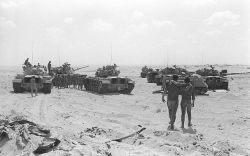Serriel-Iskiram War
| Serriel—Iskiram War | |||||||
|---|---|---|---|---|---|---|---|
 Serrielan tanks in the Kusrah desert, 1973. | |||||||
| |||||||
| Belligerents | |||||||
|
|
| ||||||
| Commanders and leaders | |||||||
|
| |||||||
| Strength | |||||||
|
|
| ||||||
| Casualties and losses | |||||||
|
|
| ||||||
The Serriel—Iskiram War was an armed conflict fought between Serriel and Iskiram from 1972 to 1977, which began with a Serrielan invasion of Iskiram on February 3, 1972 and ended with the signing of the Treaty of Shimalut on October 12, 1977. Serriel justified its invasion by claiming a need to protect the rights of Iskiram's Suhar minority, although historians believe that the desire to control the Sufaj Waterway was a greater impetus for the invasion. Serriel also wished to constrain Iskirami expansionism and define itself as the dominant power of northern Neria. The war was noteworthy for the immense material support to both sides from foreign powers, which exacerbated and prolonged the conflict, as well as the human rights abuses perpetrated by both sides during the conflict, including attacks on civilian targets, execution of prisoners of war, and Iskiram's use of chemical weapons.
Although the better-trained and better-equipped Serrielan forces initially made swift advances, thanks greatly to the Serrielan Air Force's complete control of the skies, the advance slowed in the Kusrah desert by 1973 in the face of fierce Iskirami opposition. Strategic blunders by Serrielan generals saved many Iskirami units from destruction, while the punishing battles of the Kusrah Campaign strained Serrielan supply lines within enemy-held territory. In 1975, the Serrielan army and air force had been blunted by years of fighting, while Iskirami numerical superiority began to wear upon Serrielan forces, leading to Serrielan defeat in the Maharakh campaign. The war continued in increasingly-bloody fashion until the September Coup in Serriel, in which elements of the military led by General Evram Sarraf deposed Sultan Denim and his advisors, leading Serriel to sue for peace.
The results of the war were significant and long-lasting for both nations. Loss of life was immense on both sides, leading to social and demographic repercussions for both nations. Serriel's territorial losses resulting from the Treaty of Shimalut animate revanchist sentiments in Serriel to this day, with the eleven-day Reprisal War of 1989 the most significant clash between the two nations. In Serriel, the ascension of General Sarraf to the position of King of Serriel resulted in a reorientation of the nation's foreign policy and a shift towards secular rule. The Suhari Revolt in Iskiram also resulted directly from the Serriel-Iskiram War, with severe consequences for the stability of western Iskiram.